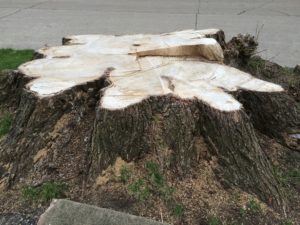By Kayla Chappell
Editor’s note: This story has been revised on 11/16/16 to clarify that residents needing help with a downed or dangerous tree should call City of Flint Street Maintenance at (810)-766-7343. That number is available 24/7, according to Angela Warren, Genesee County Conservation District administrator. City of Flint officials can do some immediate tree removal, while assessment for follow-up needs goes through the city to the GCD.
When a large branch broke off from a silver maple tree in the parkway between John Pendell’s house and Maxine Street in the College Cultural Neighborhood and landed across the street and his front yard, he took matters into his own hands,
“I didn’t bother calling the city about it,” Pendell said. “There’s very little trust around here in the motives and competence of city, county, or state government—that they might do some tree-cutting for the good of all, for instance, is hard for people to believe. Thanks, water crisis.”
Pendell is one of the many homeowners affected by the fate of the silver maple trees lining the neighborhood parkways. The streets of the CCN are known for their canopies of green, but now the trees are aging past their lifespan, and creating concerns that highlight not just the horticultural issues but challenges to the city’s overburdened delivery of basic services.
While some residents have requested that the city remove dying or dead trees in the parkway, others complain that some of the stately maples have been cut down without notice to the homeowners. Some say the trees are part of why they love the neighborhood, regret their disappearance, and wonder how the decisions to extract them are being made.
Pendell reflects the automatic low expectations of many residents about city services, adding, “If this were another city, I imagine regular tree maintenance and evaluation would be done. But here, I suspect there’s no way that the city could manage that task financially.”
However, whether or not it works to residents’ satisfaction, a system exists to do just that.
 Disposition of the trees in the CCN – and in the city in general — is coordinated through the Genesee Conservation District, one of 78 conservation districts in the state providing technical assistance on conservation issues in partnership with local, state and federal officials. The GCD is governed by a locally elected five-member board.
Disposition of the trees in the CCN – and in the city in general — is coordinated through the Genesee Conservation District, one of 78 conservation districts in the state providing technical assistance on conservation issues in partnership with local, state and federal officials. The GCD is governed by a locally elected five-member board.
Seeking a vibrant “urban forest”
Angela Warren, Genesee Conservation District administrator, leads efforts to identify and extract problem trees and simultaneously create a vibrant “urban forest.” She acknowledges availability of public resources has changed, sending the GCD to philanthropic sources for solutions to the city’s arboreal needs.
Warren says the Genesee Conservation District’s current budget is approximately $575,000, from sources including the City of Flint, Ruth Mott Foundation, and United Way of Genesee County. The GCD has additionally received funding from the Michigan Department of Natural Resources in the past and continues to seek “much needed” additional funds, Warren states.
While noting that that the City of Flint no longer has the forestry staff it once did, she adds, “Genesee Conservation District (GCD) has continuously improved the residential notification process for both scheduled and reactive urban forestry services provided on city-owned “street trees” located between the sidewalk and the curb.
She says the GCD has “integrated a courtesy notification process by way of an informative door hanger, which is left at each address where the tree is assigned.”
“Genesee Conservation District is interested in the health of our natural resources,” she says. “Specific to urban forestry, the District has prioritized, and has actively been involved in this work for nearly a decade,” according to Warren,
She said the GCD is “working rotationally throughout the City of Flint maintaining the highest priority needs. With support from Michigan Department of Natural Resources, we also have a longer term Forestry Management Plan.”
Almost 30,000 “street trees”
Warren said a GCD contractor completed a full street tree inventory and assessment in January 2015. All data are stored and maintained by the District. She said every tree maintenance, removal, planting or pruning, is documented in the software program.
A snapshot of selected data from the City of Flint’s 2015 street tree inventory showed a total of 29,563 street trees. Of those, the department identified 2,113 as “critical removals” and 4,174 for “immediate removals.” Further, upwards of 12,000 trees were identified as needing raises, where overhanging branches are cut up from the bottom, and cleanings, which includes pruning, overgrown trees and removal of dead limbs.
The 2015 data is available on the City of Flint Planning Department website, http://flint.maps.arcgis.com/home/webmap/viewer.html?webmap=b96ea2daae2040f4ae9c762567f97475.
Threats to city trees
Urban trees like those in the College Cultural neighborhood face many challenges, according to Brian VanPatten, horticulturist at For-Mar Nature Preserve and Arboretum. It’s not just that many of the silver maples, most planted in the 1930s, are at or past their life span.
Challenges for urban-growing trees include compaction, space to grow, scorch from heat coming off of the roads, salt, crown dieback, and tree maturity, VanPatten explains.
“A thing to think about when it comes to silver maples is maples, usually as a whole, have a shallow root system…they are a faster growing tree and usually with faster growing trees you’ll get a weaker-wooded tree which means that it’s more prone to breakage.
“Being weak-wooded, it does not support the loads that are on it, and that will cause the breakage,” he says.
An overpopulation of maples
Warren states that “Flint overall is overpopulated with maples, which may account for some in the community to perceive that a certain species is prioritized for removal.”
And VanPatten suggests that these weak-wooded trees may not be the best choice for urban settings due to the targets that may be damaged by falling limbs — like John Pendell and his children, or a home, a car, or a pedestrian.
Some of the things that could make silver maples costly to maintain, VanPatten says, are an increased growth rate which means more pruning cycles and in the end, more maintenance costs. “The weaker wood could mean storm damage, which means cleanup, which could mean possible lawsuits against the city if damage occurs to property,” he says.
The trees also have benefits, he adds: storm water runoff retention, longevity of asphalt, shelters for homes, lower air conditioning costs, mental health benefits, and, according to social science research, even crime reduction.
But how the trees are selected and planted makes a difference. VanPatten points to dangers that may result from a single species community, for example. He says a “monoculture” is more susceptible to being completely wiped out from disease or infestation.
Pendell sees the other side, too, if all the trees were to disappear.
“I know that many would be concerned about a mass tree clearance in our neighborhood, and how it would change the look and feel of it,” he says.
Warren states, “The City of Flint and Genesee Conservation District are striving for a vibrant urban forest. In this effort, we are utilizing data followed by on-site tree assessments to determine failure risk which direct maintenance.”
“No perfect tree”
Like Pendell, VanPatten is concerned about removal of a large number of trees from a community, without the correct replacement. Asked which species of tree should replace silver maples VanPatten responded, “There is no perfect tree.”
He suggested in an urban environment there are many factors to take into account and that a monoculture is not the answer.
“Diversity equals sustainability,” he said, concluding, “Maybe the idea is to not plant as many silver maples. Maybe there are improved cultivars that may have better form, better growth rate.”
GCD is responsive to emergency tree calls “24/7/365” according to Warren. Concerns about any city-owned tree should be directed to City of Flint Street Maintenance at (810)-766-7343. Revision/clarification of 11/16/16: residents needing help with a downed or dangerous tree should call City of Flint Street Maintenance at (810)-766-7343. That number is available 24/7, according to Angela Warren, Genesee County Conservation District administrator. City of Flint officials can do some immediate tree removal and are responsible for contacting the GCD for assessment and followup as needed. The two units work together to deal with “street tree” issues, Warren said.
Staff writer Kayla Chappell can be reached at kachappe@umflint.edu. EVM Editor Jan Worth-Nelson contributed to this story. She can be reached at janworth1118@gmail.com.


You must be logged in to post a comment.